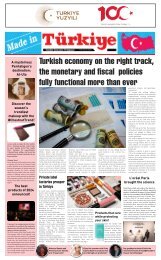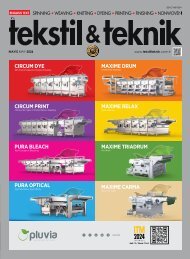Automotive Exports December 2019
- No tags were found...
Create successful ePaper yourself
Turn your PDF publications into a flip-book with our unique Google optimized e-Paper software.
September expects a current account
surplus-to-GDP ratio of 0.1% for 2019.
It forecasts the current account to post
a deficit of 1.2% next year and 0.8% in
2021 before reaching 0% in 2022.
In 2010 and 2011, when the Turkish
economy was seeing high growth, the
annualized current account deficit
had increased gradually and reached
its historic peak in October 2011 with
$76.1 billion. It went on to fall below
$50 billion in November 2012 with
the measures taken by the economic
administration.
Meanwhile, the economic confidence
index increased by 14.7 points in
October compared to the same month
of the previous year, reaching 89.8 – the
highest in the last 15 months, according
to the TurkStat data released.
Albayrak emphasized the significance
of protecting economic gains and
ensuring a sustainable growth trend
in the rebalancing period. He recalled
that the capacity utilization rates are
higher in the third quarter compared to
the previous quarter. “The contracting
automobile and home appliance sectors
also saw an increase of 100.7% and
7.2% in September,” he said, adding
that, “The Purchasing Manufacturer
Index (PMI) edged over 50 points in
September after 17 months.”
During his meeting with the
businesspeople, Albayrak also
announced an employment-oriented
financing package to be provided by
three public lenders, namely Ziraat
Bank, Halkbank and Vakıfbank.
The banks have introduced four
new instruments to facilitate longterm
loans for companies that have
the potential to produce additional
employment. The manufacturing
enterprises that pledge additional
jobs will be able to benefit from a loan
package of TL 100,000 to TL 200,000.
Albayrak confirmed that a new era
of financial support for the real
economy has started as the banks
have decreased interest rates on
commercial loans from 13% and 15.5%
to 11% and 13.5%, respectively.
Turkey’s central bank went on to lower
its inflation forecast for the end of
this year to 12% in its latest quarterly
inflation report, down from 13.9% in
the previous report, attributing it to
changing food inflation expectations
and improvement in the underlying
trend. Unveiling the last quarterly
inflation report of the year in Istanbul,
Murat Uysal, the governor of the
Central Bank of the Republic of Turkey
(CBRT), said significant improvement in
the underlying trend of inflation and the
downward revisions to import prices
and food prices had a positive impact
on the year-end inflation forecast
compared to the previous reporting
period.
However, Uysal noted, the moderate
recovery in the output gap and the
tax hikes for alcoholic beverages and
tobacco product pushed the year-end
inflation forecast upward, putting it at
12%. He added that the projections for
next year and 2021 were left unchanged
at 8.2% and 5.4%, respectively.
The governor stressed the focus of
eventually bringing down inflation to
below 5% over the medium term.
Annual inflation dropped to 9.26% in
September, reaching single digits for
the first time since July 2017, when
consumer prices came in at 9.79%. It
went down 5.75 percentage points from
15.1% in August.
After topping 25% in September last
year, inflation has been gradually
falling, from 20.3% this January to
9.26% in September.
In the face of rising inflation, the CBRT
had hiked its benchmark policy rate
– the one-week repo auction rate – to
24% in September 2018, from 17.75%
at the time. However, the disinflation
trend has paved the way for the central
bank to kick off an easing cycle in its
monetary policy and slash the oneweek
repo auction rate by 1,000 basis
points since July.
In its July meeting, the bank cut the
one-week repo auction rate by 425
basis points, before slashing the
rate further by 325 basis points in
September and 250 basis points to 14%,
taking advantage of slower inflation and
a steadier lira.
At the point reached, Uysal
acknowledged that the bank has used
a significant part available for a loose
monetary policy, but did not rule out
further easing in the near term.
Uysal said the latest rate cut was due
not only to base effects but also to
improvements in inflation expectations
and pricing behavior. He said the bank’s
future policy steps would depend on
further developments in inflation.
According to the governor, the
disinflation process continues, with
base effects, tight monetary policy and
domestic demand also contributing to
a fall in inflation, while the monetary
policy implementation will ensure the
forecast is achieved.
Under the new economic program
released last month, Turkey’s inflation
target for this year is 12%, followed by
8.5% in 2020, 6% in 2021 and 4.9% in
2022.
December 2019
72

















